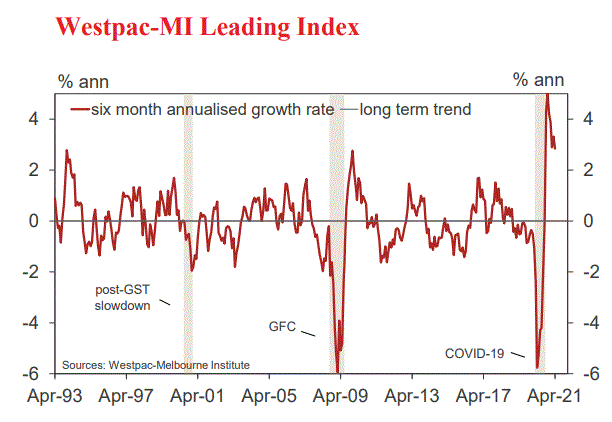Via Westpac:

• The six-month annualised growth rate in the Westpac Melbourne Institute Leading Index, which indicates the likely pace of economic activity relative to trend three to nine months into the future, eased from 3.31% in March to 2.85% in April.
The Leading Index growth rate continues to point to strong above trend growth momentum carrying through the second half of 2021 and into early 2022. While the pace of gains has moderated, this is coming from an extremely strong starting point after the Index growth rate hit record highs late last year. April’s read may be down on those peaks, but it is still above all other growth rates recorded since the early 1980s.
The signal is consistent with Westpac’s growth forecasts for the Australian economy: we expect GDP to post a very strong 4.5% gain in 2021, growth moderating only marginally to a 4% pace in the first half of 2022. The moderation mainly reflects the cycling of a very strong initial bounce coming out of last year’s COVID lockdowns.
With initial reopening rebounds now largely complete, other drivers are set to take over with upbeat, cashed-up households and booming housing markets setting what will still be a strong pace for growth.
That shift is evident in the Leading Index component detail.
The slowing in the Index growth rate from 4.34% to 2.85% over the last six months has centred on two components: US industrial production (contributing –2.1ppts) and total hours worked (–1ppt). Both saw extremely strong ‘reopening rebounds’ as COVID restrictions were eased late last year and are now settling back into more normal, but still above-trend, growth rates.
These drags have been significantly offset by gains elsewhere. A big lift in commodity prices – record iron ore prices driving a 20%+ gain over the last six months – has added +0.8ppts to the headline growth rate. Most other components have also seen improved positive contributions: dwelling approvals, the yield spread, the ASX and the Westpac-Melbourne Institute Unemployment Expectations Index all adding +0.2-0.3ppts each to the Index growth rate over the same period (a combined boost of 1.1ppts).
The broad base of these offsets points to momentum being well balanced as well as strong. All components are contributing to the above trend headline growth rate – a ‘unanimous’ picture of strength that, prior to COVID, has only been seen in three other months over forty-year
history of the Index.
The Reserve Bank Board next meets on June 1. The minutes of the May Board meeting confirmed that the Board will decide on the next stage of its Yield Curve Control (YCC) and Quantitative Easing (QE) policies at its July meeting.
As such, the next meeting in June will be one of ‘marking time’ and discussing the recent run of data.
The May minutes noted that recent data and financial conditions will be factors influencing the decisions in July.
Westpac expects the Board to extend the QE policy to a further $100 billion beginning in September and to switch the target bond in the YCC policy from April 2024 to November 2024.
This view is based on the expectation that the Board will be committed to monetary stimulus (reducing QE or restricting YCC to the April bond are akin to tightening policy) for the remainder of 2021. Despite more promising signs around momentum there is still much to be done for the Bank to achieve its objectives of full employment and its inflation target.

